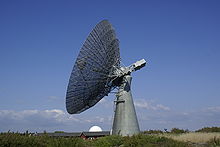- Onsala Space Observatory
-
Onsala Space Observatory 
Logo of the Onsala Space ObservatoryOrganization Chalmers University of Technology Location Onsala, Gothenburg, Sweden CoordinatesAltitude 20 m Established 1949 Website
Onsala Space Observatory websiteTelescopes20 metre single-dish movable 25 metre single-dish movable LOFAR station interferometer Onsala Space Observatory (OSO), the Swedish National Facility for Radio Astronomy, provides scientists with equipment to study the Earth and the rest of the Universe. The observatory operates two radio telescopes in Onsala, 45 km south of Göteborg, and takes part in several international projects. Examples of activities:
- The 20 and 25 m telescopes in Onsala: Studies of the birth and death of stars, and of molecules in the Milky Way and other galaxies.
- LOFAR station: The Swedish station in the international radio telescope LOFAR is located at the observatory.
- VLBI: Telescopes in different countries are linked together for better resolution ("sharper images").
- ALMA, e-VLBI, Herschel Space Observatory, SKA: Developing and using new radio astronomical facilities.
- APEX: Radio telescope in Chile for sub-millimetre waves. Research about everything from planets to the structure of the Universe.
- Odin: Satellite for studies of, e.g., the Earth's atmosphere and molecular clouds in the Milky Way.
- Space geodesy: Radio telescopes (VLBI) and satellites (GPS) are used to measure movements in Earth's crust and water vapour in the atmosphere.
- Receiver development: Laboratories for development of sensitive radio receivers.
Onsala Space Observatory was founded in 1949 by professor Olof Rydbeck. The observatory is hosted by Department of Earth and Space Science at Chalmers University of Technology, and is operated on behalf of the Swedish Research Council.
Contents
25-metre telescope
The 25.6 m diameter, polar mount decimeter-wave telescope in Onsala is equipped with receivers for frequencies up to 7 GHz. It is used for astronomical VLBI observations. It is also operated as a single dish for studies of molecular clouds in the Galaxy. The telescope was built in 1963.
20-metre telescope
The 20 m diameter, radome enclosed, millimetre wave telescope in Onsala is equipped with receivers for frequencies up to 116 GHz. It is used for observations of millimetre wave emission from molecules in comets, circumstellar envelopes, and the interstellar medium in the Galaxy and in extragalactic objects.
It is also used for astronomical VLBI observations of star forming regions, radio stars, and active galactic nuclei, and for geodetic VLBI observations to study e.g. crustal dynamics and polar motion. The telescope was built in 1975-76 and upgraded in 1992.
It is also used, as part of the European and world-wide networks, for astronomical Very Long Baseline Interferometry (VLBI) observations of star forming regions, radio stars, and active galactic nuclei, and for geodetic VLBI observations to study e.g. crustal dynamics and polar motion.
Receivers
The telescope is equipped with the following receivers:
Frequency range Receiver temperature Receiver type Polarization 2.2–2.4 GHz 60 K HEMT amplifier Single 8.2–8.4 GHz 80 K HEMT amplifier Dual 18.0–26.0 GHz 30 K HEMT amplifier Dual 26.0–36.0 GHz 50 K HEMT amplifier Single 36.0–49.8 GHz 50 K HEMT amplifier Dual 85–116 GHz 80–130 K SIS mixer Single LOFAR station
The Swedish station in the international radio telescope LOFAR is located at Onsala Space Observatory. It was completed in 2011[1].
External links
- Onsala Space Observatory - Official site
References
- ^ "Education minister to open Onsala’s LOFAR station (Chalmers press release), 30 June 2011". LOFAR Sweden consortium. http://lofar-se.org/?p=371.
Categories:- Radio telescopes
- Astronomical observatories in Sweden
- Science and technology in Sweden
Wikimedia Foundation. 2010.



